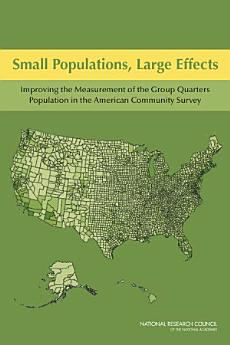Small Populations, Large Effects: Improving the Measurement of the Group Quarters Population in the American Community Survey
About this ebook
The decision to include group quarters in the ACS enables the Census Bureau to provide a comprehensive benchmark of the total U.S. population (not just those living in households). However, the fact that the ACS must rely on a sample of what is a small and very diverse population, combined with limited funding available for survey operations, makes the ACS GQ sampling, data collection, weighting, and estimation procedures more complex and the estimates more susceptible to problems stemming from these limitations. The concerns are magnified in small areas, particularly in terms of detrimental effects on the total population estimates produced for small areas.
Small Populations, Large Effects provides an in-depth review of the statistical methodology for measuring the GQ population in the ACS. This report addresses difficulties associated with measuring the GQ population and the rationale for including GQs in the ACS. Considering user needs for ACS data and of operational feasibility and compatibility with the treatment of the household population in the ACS, the report recommends alternatives to the survey design and other methodological features that can make the ACS more useful for users of small-area data.







